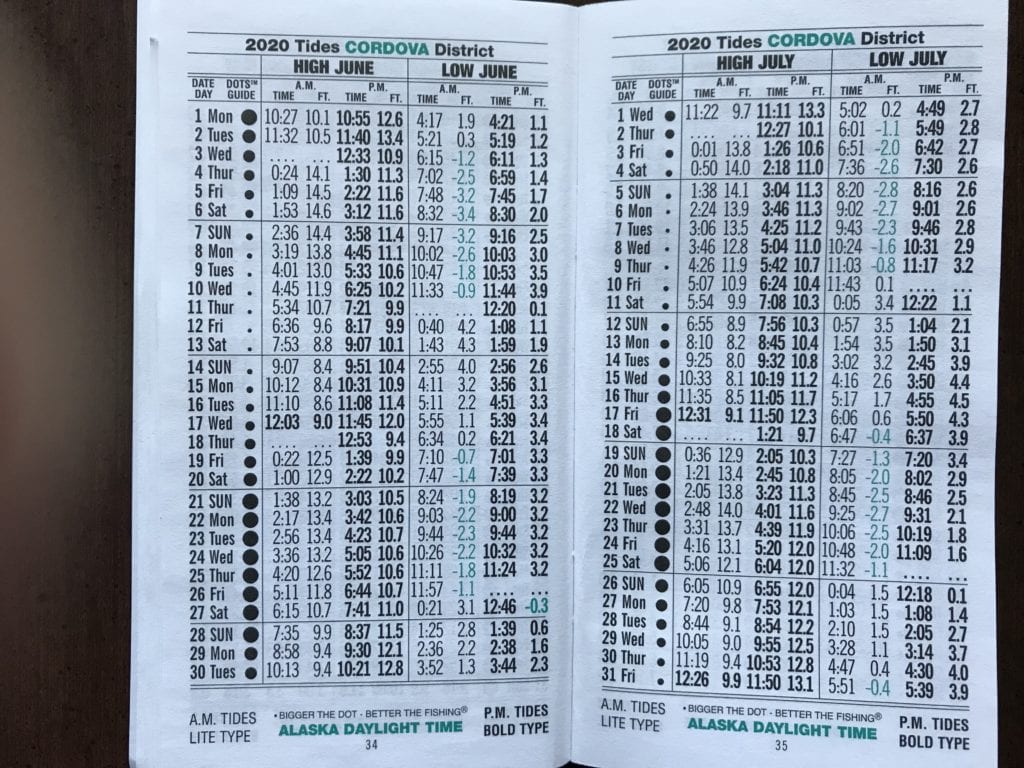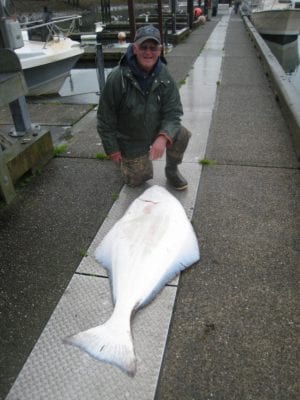
Containing 109 pages, measuring a compact 3×6 inches, and weighing two ounces, it’s undoubtedly the most read book in Cordova.
Filled with columns of numbers generated by complex scientific methodologies, featuring decimal points as well as a scattering of minus symbols, it is distributed freely at local hardware, grocery and fishing supply stores, as well as banks, fuel docks and telecommunications centers.
It finds its place in every fisherman’s pocket, and on the bridge of every vessel, usually with the upper corners of pages 20 to 28 torn off, to create easy and quick access to the section titled “Tides CORDOVA District”, beginning on page 29.
Considering the thousands to hundreds of thousands of dollars that ride on decisions based on its contents, it is rather amazing that tide books, which in this case cover Anchorage, Seldovia, Cordova, Kenai, Ninilchik, Kodiak, Seward and Valdez, come at no charge.
The fisherman’s equivalent of the Farmer’s Almanac, its contents fascinate the young and the old.
Ever since he was 9 months old, my young grandson Huckleberry Cole Morehead from Texas has asked me to explain the tides in Odiak Slough as we busily play in a sandbox on the beach in front of our house.
My discourse that “the tide comes in, and the tide goes out” no longer passes muster, especially since it does so twice a day; yet the addendum that it is all because of “the Man in the Moon” does contain a bit of scientific truth.
For a more detailed and fascinating analysis of the ebb and flow of sea waters worldwide, I recommend “Tides: The Science and Spirit of the Ocean” by Jonathan White.
This very readable global journey through the science and wonder of this basic yet complex phenomena would be a great item to have onboard for gill netters who miscalculate the tides while taking shortcuts across “The Flats” on the way to their favorite spots on the Copper River Delta, and end up missing precious hours of early season fishing in 12 or 24 hour openers while high and dry.

Not surprisingly, it also helps to make sure one checks the year of the tide book before heading out for an opener. Lifetime Cordova fisherman Pete Blake related a story about barely screaming through “the Hump”, the shallowest spot in the channel between Whitshed and Egg Island, on what he thought was a hold-up tide, only to realize he was looking at a tide book for the prior year.
Oops.
Meanwhile, back in Austin, Huck has a tide book on a shelf beside his bed, and will, when we Facetime, ask for a view of the slough in front of our house, adding comments like, “Wow, that’s a 14-foot tide, Grandpa.”
Trips to our duck cabin down Pete Dahl via Alaganik Slough are increasingly tide-dependent as the waterways continue to silt it, and my competent little navigator always checks for a set of 13-foot or higher tides to consult with his mom Heidi before scheduling their annual summer visit.
This little book is also replete with a plethora of information besides the state of the tide, which can be pretty obvious when one miscalculates and ends up high and dry.
It includes pages listing holidays and anniversaries; important telephone numbers; Cordova District correction table (pages 41-42: Example: The low tide at Pete Dahl Entrance is 58 minutes after what is indicated in the tide book); fisherman’s knots; a calendar; guides to hypothermia and “in water” survival; location of National Weather Service marine weather forecasts; visual storm and distress signal; motorboat regulations; navigation rules (Ex: red on right returning); and useful mariners measures (ex: a 5 gallon jug of gas weighs 40 pounds).
One of my favorites is the halibut length/weight table. Unlike human beings, whose poundage varies dramatically for any given height, halibut weights are amazing consistent for any given length, and all it takes is a tape measure to figure out the weight of these flat fish. For example, a 48 incher, (from tip of nose to v-notch in tail) weights 53 pounds, and it takes a length of 59 inches to break the 100-pound mark, which equals a 103-pound lunker.
While perusing this treasure trove of information, it is also entertaining to notice the variation in tides in other areas. For example, Anchorage has extremes that go from a high of 33.6 feet to a low -3.6, which makes Cordova changes small by comparison.

Incidentally, the largest tide variation in the world is 53 feet, in the Bay of Fundy. This is described in great detail in White’s book, as are the amazing methods used to figure out tides at any place on the planet.
This year’s Cordova Telecom Cooperative tide book also contains a new addition, certain to delight my grandson, who is now in first grade: on the next-to-last pages, a nautical word search game, that includes terms such as alee, cleat and port.
Alas, this year’s tide books did not come out in time for Christmas stocking stuffers, but Huck’s will soon be in the mail to a place in Texas 200 miles from the ocean, where, at bedtime, his father will likely have to use terms from the word search and say, “Avast, my laddie, it’s time to batten down the hatches, check your bilge, drop anchor, and head to your berth for the night.”
And should this young mariner find difficulty falling asleep, instead of counting sheep, he can count tides already bookmarked for Cordova in July 2020, when he will once again be able to view the magical ebb and flow of the waters of Odiak and Pete Dahl Slough.





